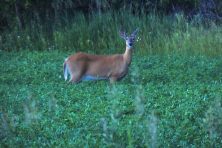Cooking Wild
- Share
- Tweet
- Pin
- Share

My earliest childhood memories on Pleasant Ridge include hunting morel mushrooms each spring. When the umbrella leaves of May Apples opened in our woods, my family knew morels wouldn’t be far behind; all the mushrooms needed was the encouragement of a warm rain, and on a good year, we’d fill paper grocery bags with our finds, oftentimes discovering them around the bases of dead elm trees.
After I moved to Door County with my wife and children, my thoughts of spring still turned to morels, and to my delight we occasionally found them, sometimes inexplicably growing in our lawn. But strangest of all, they tended to pop up near our evergreen windbreak, perhaps nurtured by soil made relatively acidic from dropped pine needles. My wife fries them in butter as a special treat, just as my mother once did.

Illustration by Ryan Miller.
Some years we make the drive to my family homestead in the southwest corner of the state hoping to find morels. My 89-year-old uncle, who lives on a neighboring farm, still tramps through his woods hunting the mushrooms.
Morels are very much a part of our family history. Our nephew, Jason Edge of Potosi, operates MorelMasters, an online company that ships local mushrooms throughout the United States and for the third year now, ramps.
Like morels, ramps (also known as wild leeks) are native to Wisconsin and can be found growing in woodland areas. While morels prefer the edges of woodlands, ramps are happiest in the deep woods. I find them growing along the tree-lined old stone fence that borders my property near Sister Bay.
Morel mushrooms are easily identified as they have upright gray or tan waffled crowns and hollow bodies. The double leaves of ramps resemble Lilies of the Valley, but with a small onion-like bulb and emit a strong garlic scent. Morels appear in Door County during May with a season of a week or two; ramps poke up their leaves in April and can be harvested into midsummer.
If you would like to stalk morels and ramps but don’t have access to private land, search the borders along country roads or visit any of Door County’s five state parks. Wisconsin State Parks have a picking and gathering policy that allows their harvest, with the exception of designated natural areas.
Should you have success, morels may be substituted in any recipe that uses mushrooms, while ramps may replace onions, especially if a garlic taste is desirable. Edge adds ramps to scrambled eggs or fried potatoes, but imagine the haute cuisine adventure of using them in omelets or vichyssoise.
For a pleasant garlic flavor, he said, “Sometimes we slice both the bulb and leaves and add them to tossed salads.”
Gibraltar High School science teacher David Tupa likes to sauté a mixture of morels and ramps to accompany venison steaks. Some of his mushroom harvest he cuts in half lengthwise and dries cut side up in the sun on cardboard or newsprint. These he uses in preparing soups and stews throughout the year, and to accompany the wild turkey that he serves for Thanksgiving.
Harvesting morels and ramps in the wild and then bringing them to your table greatly expands the dining experience. The primal connection with nature will satisfy not only your appetite, but also your spirit.
To purchase Wisconsin morels or leeks online, contact Jason Edge at [email protected] or visit morelmasters.com.
Jones Family Recipe for Fried Morel Mushrooms
Keeping in mind that morels are very fragile, clean the freshly picked mushrooms with a soft brush only as necessary. Slice in half lengthwise, and soak them for an hour or two in saltwater to remove any insects. To cook the mushrooms, rinse them in fresh water, pat them dry with paper towels, lightly dust them with flour, and fry them in butter at a medium temperature until they are a golden-brown. Serve immediately.
After drying morels, David Tupa, as an act of environmental responsibility, cuts up and buries the paper on which the mushrooms were dehydrated to encourage growth from any remaining mushroom spores.
Should you prefer to go wild in a restaurant rather than in a forest, upscale eateries, such as the Mission Grille in Sister Bay, sometimes feature seasonal morels and ramps in entrees.


